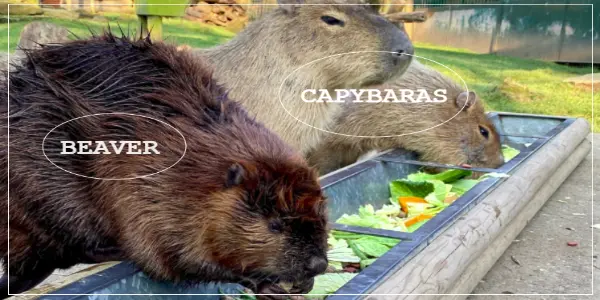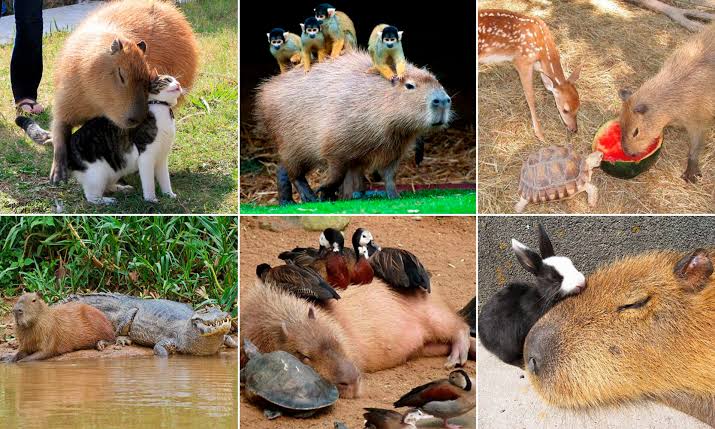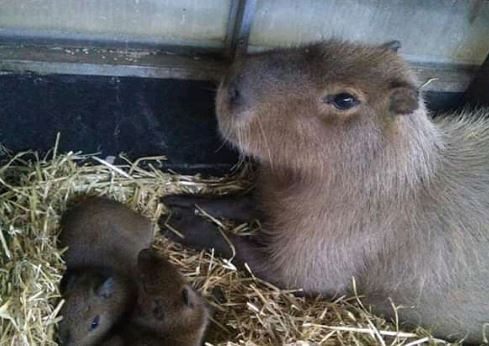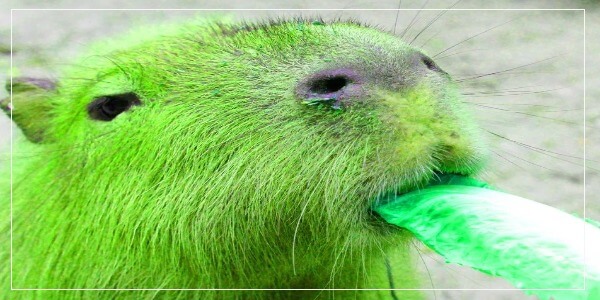Capybaras and beavers are both semi-aquatic mammals that can be found in different parts of the world. While they share some similarities, they also have some differences. Here are 15 similarities and differences between capybaras and beavers:
Similarities:
- Semi-aquatic: Both capybaras and beavers are semi-aquatic animals that spend a lot of time in and around water.
- Herbivorous: Both animals are herbivores that feed mainly on vegetation.
- Social animals: Both capybaras and beavers are social animals that live in groups.
- Good swimmers: Both animals are good swimmers and can hold their breath for a long time underwater.
- Nocturnal: Both capybaras and beavers are nocturnal animals and are most active at night.
- Tail: Both animals have distinctive tails that are important for swimming and communication.
- Gestation period: Both animals have a relatively long gestation period.
- Diurnal activity: Both animals can be active during the day in areas where they feel safe.
- Have special adaptations for underwater living: Both animals have unique adaptations that allow them to thrive in aquatic environments.
- Build shelters: Both animals build shelters to protect themselves from predators and the elements.
Differences:
- Location: Capybaras are found mainly in South America, while beavers are found in North America and Europe.
- Size: Capybaras are larger than beavers, with a length of up to 4 feet and a weight of up to 140 pounds, while beavers are up to 3 feet long and weigh up to 70 pounds.
- Diet: While both animals are herbivores, capybaras feed mainly on grasses and aquatic plants, while beavers feed on tree bark and branches.
- Teeth: Beavers have prominent front teeth that never stop growing, which they use to fell trees, while capybaras have flat teeth for grinding vegetation.
- Water sources: Capybaras prefer still or slow-moving water sources, while beavers prefer flowing water sources.
- Physical appearance: Capybaras have a more slender build, while beavers have a stockier build with a more distinct snout.
- Dams: Beavers build dams to create ponds, while capybaras do not build dams.
- Reproduction: Beavers mate for life, while capybaras mate with multiple partners.
- Habitat: Beavers live in wooded areas near water, while capybaras live in grasslands near water.
- Lifespan: Beavers have a longer lifespan than capybaras, with an average lifespan of 10-15 years, while capybaras live up to 8 years in the wild.
- Physical abilities: Beavers are capable of swimming, diving, and carrying heavy logs, while capybaras are mainly good swimmers.
- Tail shape: The tail of beavers is flat and wide, while the tail of capybaras is more cylindrical.
- Communication: Beavers communicate by slapping their tails on the water, while capybaras communicate through vocalizations and scent marking.
- Predators: Both animals have different predators. Beavers are preyed upon by coyotes, wolves, and bears, while capybaras are preyed upon by jaguars, anacondas, and caimans.
- Hibernation: Beavers hibernate during the winter months, while capybaras do not hibernate.
Can Capybaras & Beavers Live Together?
Capybaras and beavers may have a hard time living together for several reasons:
- Habitat: Capybaras are native to Central and South America, while beavers are found in North America, Europe, and Asia. Their habitats do not overlap.
- Climate: Capybaras prefer warm, humid climates, while beavers are adapted to colder, temperate climates. They have different temperature requirements.
- Water: Beavers build dams and lodges in bodies of water, while capybaras live near bodies of water but do not build structures. They have different water-related behaviors.
- Diet: Capybaras are herbivores and primarily eat grasses and aquatic plants, while beavers are also herbivores but mainly eat the bark and twigs of trees. They have different dietary needs.
- Social Behavior: Capybaras are social animals and live in groups, while beavers are also social but usually live in pairs or small family groups. They have different social needs.
- Size: Capybaras are much larger than beavers, which could result in competition or conflict.
- Behavior: Beavers are known for their dam-building behavior, which could disrupt the habitat of capybaras.
- Aggression: Capybaras can be aggressive and territorial, which could lead to conflicts with beavers.
- Predators: Capybaras are preyed upon by jaguars and other predators in their native habitat, while beavers are preyed upon by larger carnivores such as bears and wolves. They have different predator-prey relationships.
- Conservation: Capybaras are considered a vulnerable species due to habitat loss and hunting, while beavers are considered keystone species for their role in shaping their ecosystem. Mixing them could have unintended consequences for their conservation.
Why Are Capybaras More Commonly adopted for pets than beavers?
There are several reasons why capybaras are more commonly adopted as pets than beavers:
- Legal status: In many places, capybaras are legal to own as pets, while beavers are not. Beavers are typically classified as wildlife and require special permits to keep.
- Availability: Capybaras are bred in captivity for the pet trade, while beavers are not as commonly bred for this purpose. This means that capybaras are more readily available as pets.
- Behavior: Capybaras are generally more docile and social than beavers, which can make them easier to handle and care for as pets. Beavers have more specialized needs and behaviors, such as dam-building, which can be difficult to replicate in a domestic setting.
- Human interaction: Capybaras are known to form close bonds with their human caretakers, which can make them rewarding and affectionate pets. Beavers, on the other hand, are not typically as social with humans and may be more difficult to train or bond with.
It is important to note that while capybaras can make good pets for some people, they are still exotic animals with specialized needs that may not be appropriate for all households. Potential capybara owners should do their research and ensure that they can provide proper care and meet all legal requirements before adopting one as a pet.




![Why Do Capybaras Not Have Tails? - [Answered] Why Do Capybaras Not Have Tails](https://capybaratips.com/wp-content/uploads/2023/03/Capy-Tail-250x200.webp)
![Capybara Meat And Its Culinary Uses - [Every You Should Know] Capybara Meat & Culinary Uses](https://capybaratips.com/wp-content/uploads/2023/03/Capybara-meat-250x200.webp)
![How Long Do Capybaras Live? - [Answered] How Long Do Capybaras Live](https://capybaratips.com/wp-content/uploads/2023/03/Capybara-Pix-250x200.webp)
![How Big Should a Capybara Enclosure Be? - [Sizes & Design] How Big Should a Capybara Enclosure Be](https://capybaratips.com/wp-content/uploads/2023/03/Capy-Enclosure-250x200.webp)

